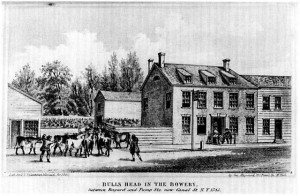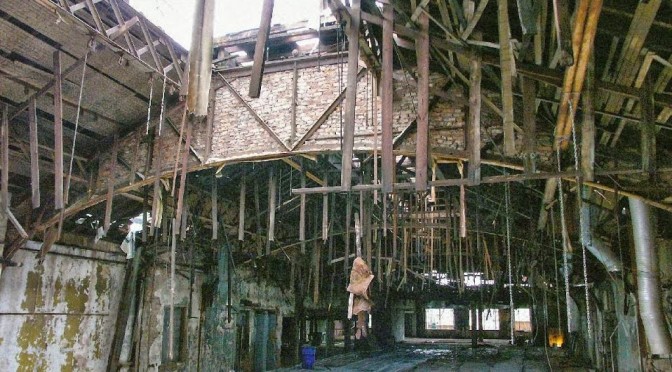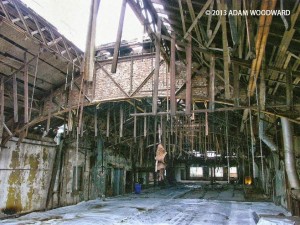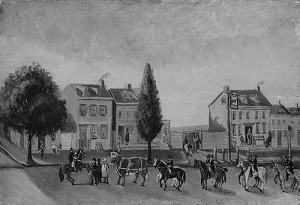The former Atlantic Gardens, revealed during a demolition. Underneath it lies evidence of an even greater historical discovery. Courtesy Adam Woodward/Lower East Side History Project
Big news on the urban archaeological front — remnants of the Colonial-era Bulls Head Tavern may have been discovered during an excavation for a new hotel. The Bull’s Head was itself built over in the late 19th century for the grand Atlantic Gardens beer hall (mentioned in our Beer History podcast). then enjoyed a rather non-descript past century at 50-52 Bowery in various guises, most recently a drug store and restaurant.
Check out the story here (Unearthed: A Possible Stop Along the Revolution) and follow The Lo Down for all the latest developments in the coming days. And take a few minutes to marvel at preservationist Adam Woodward’s photographs of the site here. It might not look like much, but verification of its identity would prove to be a pretty big deal for lovers of American history.
Below, I’m re-posting my article from 2009 on the history of the Bull’s Head Tavern.
__________________

The Bull’s Head Tavern was the gathering-place for farmers, drovers, and merchants in the 18th century, located well outside city boundaries just east of Collect Pond. (At the Bowery, right at the entrance to the Manhattan Bridge.)
It soon became the center of Manhattan’s entire meat selling and rendering industry, with the area surrounding the nearby Collect overrun with tanneries and slaughterhouses. As the Bull’s Head was also located right on the Boston Post Road (later the Bowery), situated at a crossroads of livestock yards and stables, it became an ideal place for both commerce and carousing.
The Bull’s Head was in operation as early as 1755, enjoying business as “the last halting-place for the stages before entering the city.”
Within the next few decades, industry enveloped the area, transforming the Bull’s Head into a cattle market, with pens adjoining the main building where farmers from the surrounding area herded their best specimens for sale. Inside the tavern became a literal stock market, with transactions, news and gossip being shared over brew and a hot meal in “smoky, low-ceilinged rooms.”
Those who lingered well into the night sometimes played a strange game called crack loo — often gambling away any profits they might have made earlier in the day. Out in the pen, dog fights and “bear baiting” sometimes occured as entertainment.
As Washington Irving describes, at the Bull’s Head he would “hear tales of travelers, watch the coaches and envy the more pretentious country gentlemen in Castor hat, cherry-derry jackets and doeskin breeches.”
On November 25, 1783, Evacuation Day, the Bull’s Head entered history. As the British fled New York that day, George Washington and his entourage met at the Bull’s Head, preparing themselves for their triumphant entry into town. Governor George Clinton and over 800 uniformed troops and town people gathered right outside, preparing for the procession.
Henry Astor, the older brother of John Jacob, stepped in as owner of the Bull’s Head in 1785. Already an accomplished butcher, Henry served his “celebrated cuts of meats” and often outpriced his own clientele when a particularly choice herd of cattle came travelling by.
Of course, New York was outgrowing its old boundaries by then. By 1813, Collect Pond had been drained and high society eyed the Bowery, sweeping away the filthy stockyards and factories to construct homes, shops and theaters. Moving with the changing times, some civic minded businessmen bought out Astor and moved the Bull’s Head somewhere safely outside the city — this time at 3rd Avenue and 24th Street!
In 1830, this new location fell into the hands of young rancher and entrepreneur Daniel Drew, who turned the tavern into a sort of bank, marketplace and social club for local cattlemen, upgrading the establishment and building his own reputation as a savvy financier. The neighborhood was even sometimes referred to as Bull’s Head Village.
 As this time, according to an old history, “various types of men mingled in the bar-room of the Bull’s Head, from the rough country man to the speculative citizen, butcher and horse-fancier. Plain apple-jack and brandy and water… were the principal liquors passed over the bar. Guests were so numerous that at the first peal of the dinner-bell. it was necessary to rush for the table or fail miserably.” And of course, after hearty meal and vigorous drink, came the gambling, “throwing dice for small stakes.”
As this time, according to an old history, “various types of men mingled in the bar-room of the Bull’s Head, from the rough country man to the speculative citizen, butcher and horse-fancier. Plain apple-jack and brandy and water… were the principal liquors passed over the bar. Guests were so numerous that at the first peal of the dinner-bell. it was necessary to rush for the table or fail miserably.” And of course, after hearty meal and vigorous drink, came the gambling, “throwing dice for small stakes.”
Drew eventually went on to become a steamboat mogul. The site of the old Bull’s Head eventually hosted the notorious Bowery Theatre (built upon its old cattleyards), then the sumptuous Atlantic Gardens by the mid-19th century. Drew’s uptown location on 24th caved in to a growing residential neighborhood and soon moved again — this time to 42nd Street. That location was famous torched during the Draft Riots.
However, near the 24th Street location, there is a new Bull’s Head Tavern that probably smells a lot better than the original.
And not to forget, there was also a Bull’s Head Tavern in Staten Island, at Victory Boulevard and Richmond Avenue. Built in 1741, this Bull’s Head was a popular destination for British-loving Tories before the days of the Revolutionary War. Before it was destroyed in a fire, “people from all over the country made special trips to the old house, just to see the famous Tory headquarters,” according to one old history.
The neighborhood that sprouts around that intersection at Victory and Richmond is named Bulls Head in the old tavern’s honor.



